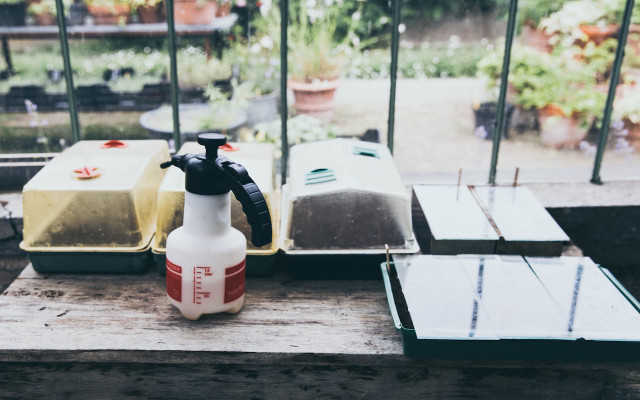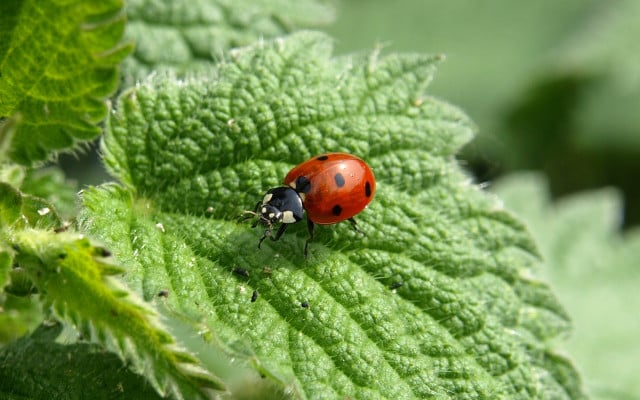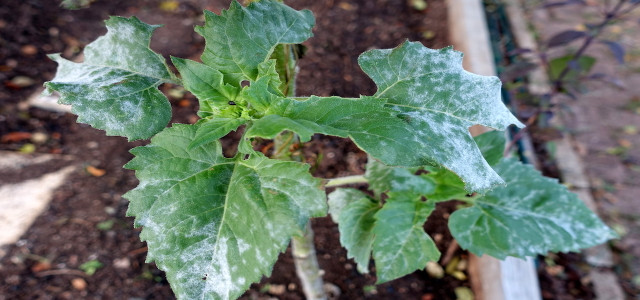No gardener likes the sight of powdery mildew on plants – but there are treatments! Try some of the following household remedies to get rid of powdery mildew.
Mildew is just the generic term for various plant diseases caused by fungi. They cause white, mealy deposits on the leaf surfaces which dry the leaves out. The affected parts of the plant then die off.
Mildew is commonly found among the following plants:
- Apple trees
- Strawberries
- Cucumbers
- Carrots
- Vines
- Roses, and other ornamental plants
Treatment of downy and powdery mildew is not easy – but there are many effective remedies.
Powdery vs. Downy Mildew
There are over 100 species of mildew with different treatments – the most common are powdery mildew and downy mildew.
- Powdery mildew breaks out quickly in dry, hot weather. Leaves don’t need to be wet in order for it to spread — it can spread by air movement.
- Downy mildew thrives under humid conditions. It spreads by splashing water, rain or heavy fog.
You can also tell the two mildews apart based on how they look and where they appear on the plants.
- Powdery mildew on plants is located on the top side of the leaves only. It appears as a white coating that will turn brown, but can be easily wiped off.
- Downy mildew on plants is located on both the top and bottom sides of the leaves. The top side will develop light/yellowish spots, while the typical white coating appears on the underside.



Found Mildew on Your Plants? Act Immediately!
When you first spot downey or powdery mildew on your plants, start the treatment immediately in order to stop the disease from spreading. But keep in mind that using chemical fungicides can often do more harm than good. This is because the toxic substances it contains accumulate in the soil and can be deposited on neighboring plants (like fruits and vegetables) depending on what’s in your garden.
Want to know how to get rid of powdery mildew the natural way? Let’s take a look at some home remedies.
Treatment: Remove Leaves Infested with Powdery Mildew
If you detect a mildew infestation in a plant, the first step is to remove the infested leaves, flowers and buds. Doing this will help ensure the disease won’t spread any further, saving the plant from dying off completely.
If the mildew infestation is severe, consider pruning the plant back completely. The chances to remove all the fungal spores are higher this way – but success is not guaranteed. If some of the fungal spores survive, they can immediately infest newly grown shoots again.
Important:
- Don’t leave the removed parts of the plant in the flower bed, or anywhere nearby. Wind and insects can cause the powdery mildew spores to spread.
- Do not put plants affected with powdery mildew in the compost! Mildew forms spores that are not affected by the decomposition process.
- You’re best off throwing the affected plant parts in organic waste containers, or even the trash.
Home Remedies for Getting Rid of Mildew



There are various household remedies you can use as treatments for powdery mildew. They are made from things you most likely already have in your house. All you need is a spray bottle (like this one on Amazon**) and you’re ready to get rid of mildew on your plants!
Milk Water Mixture
Application: Mix together one part milk (or buttermilk) to nine parts water and spray several times a week on the infested leaves/plants.
How it Works: The lactic acid bacteria fight the fungi while the sodium phosphate contained in the milk. This makes the plant more resistant to infestation.
Note: This method will not work against downy mildew, it only works as a powdery mildew treatment.
Baking Soda Mixture
Application: Mix 1 ½ tablespoons of baking soda with half a gallon of water and four teaspoons of oil. Spray the mixture onto the plants every two weeks.
How it works: The mixture of water with baking soda creates a slight alkaline reaction, which is effective against the fungi.
Note: This method will not work against downy mildew, it only works as a powdery mildew treatment.
Garlic Broth
Application: Cut four garlic cloves into small pieces and pour boiling water over them. Allow to steep until cool, then strain the garlic out and catch the water in a spray bottle. Spray your plants every couple of days.
How it works: Garlic contains certain active ingredients, like sulphur, mildew-causing fungi don’t like.
Get Rid of Powdery Mildew Naturally with Ladybugs



Ladybugs are incredible insects that are absolutely beneficial to every garden. They love munching on aphids and mildew, two of the worst pests in the garden.
Don’t have any ladybugs in your garden? Not to worry! Most garden centers or hardware stores will carry them. Just add them to the affected area of your garden.
Although ladybugs are very effective at getting rid of powdery mildew, they can’t prevent it from developing.
How to Prevent Mildew in Plants
Sometimes downy or powdery mildew is so persistent that treatment is futile. Be proactive and start fighting against powdery mildew before a breakout occurs! Consider the following measures:
- Distance: leave plenty of space when planting to ensure each plant gets enough air and light. The closer together they’re planted, the more susceptible they are to downy mildew.
- Combination Planting: certain plants have a fungus repelling effect. Plant them between higher risk plants for a healthy symbiotic relationship. Planting garlic near roses and strawberries, or basil and chives near lettuce will have that effect.
- Weeding: weeds are infested very quickly which gives fungal spores an easy way to spread. Try to keep your beds free of weeds — especially near the plants susceptible to mildew.
- Proper Watering: the best time to water is first thing in the morning, however you can also water in the early afternoon. This gives the sun enough time to dry the leaves, which prevents moisture (the main cause of downy mildew).
This article has been translated from German by Karen Stankiewicz. You can find the original here: Mehltau bekämpfen: Diese Hausmittel helfen deinen Pflanzen
Important Information regarding Health-related Topics.
** Links to retailers marked with ** or underlined orange are partially partner links: If you buy here, you actively support Utopia.org, because we will receive a small part of the sales proceeds. More info.Do you like this post?







